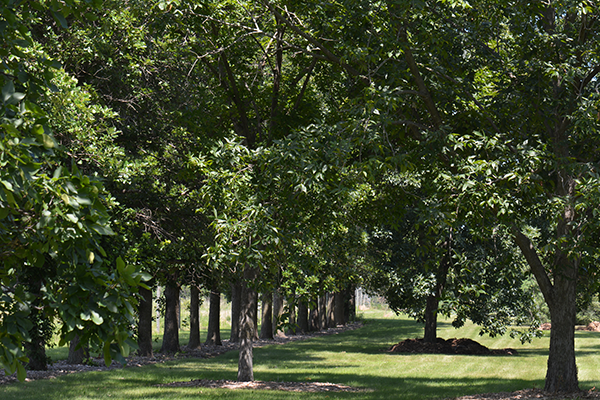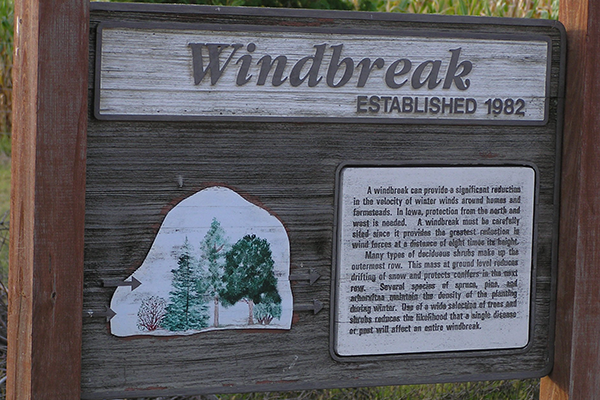Windbreak


Windbreaks serve several important functions in the Iowa landscape, and can be seen anywhere from farm fields, to home gardens, to city landscapes. Especially after a devastating derecho in 2020, Iowans know the damage of high winds and are finding creative ways to prevent destruction from wind.
The Iowa Arboretum’s current windbreak was planted over several years beginning in 2022. The design and plant lists were meticulously drafted by the arboretum’s curator. Several rows of woody plants begin on the windward side with shrubs, small trees, gradually growing to large deciduous trees. These three to four rows of trees reduce the wind speed and directs much of the wind up and over the windbreak. The primary function is to prevent the full brunt of wind hitting the deeper conifer layers and causing breakage, as was seen during the 2020 derecho. The deciduous trees reduce the wind load and diffuse the stress of high winds across a much larger group of trees. The conifers five and six layers deep then further reduce wind speed. Individual rows of trees were planted at their maximum recommended spacing to extend the life of the windbreak beyond the average 50-75 years. It will take several years for the full effects of the windbreak to begin, but the windbreak itself won’t need replacement for hopefully 100 years or more.

The design of the windbreak is meant to achieve several main goals:
The first goal is to weaken wind onto the arboretum’s grounds and protect the collection from damaging high winds. While many of the arboretum’s trees are tolerant to wind, excessive drying winds during the winter and hot dry air during the summer can wick moisture from trees resulting in dieback. The arboretum regularly experiences wind speeds greater than 40 mph, so keeping more delicate trees protected is important. While many people plant windbreaks as a living snow fence, the purpose of the arboretum’s windbreak design is to keep as much snow from blowing off the property as possible. The species selected and tree spacing provides low density, so wind is slowed down rather than blocked. Snow spreads and settles on the leeward side of the windbreak, melting slowly and percolating deep into the ground, making the surrounding landscape more resilient to drought conditions.
The second goal is to serve as an experiment and demonstration of a wide range of native tree species that can be used in windbreaks. Over three dozen tree species have been used in this windbreak so far, including oaks, hickories, maples, hackberries, buckeyes, and much more. This great diversity of trees gives the arboretum the ability to evaluate the performance of specific trees as a windbreak tree recommendation. The diversity of tree types also means that the windbreak as a whole will have a resilient future, diseases and pests will not be able to wipe out large sections of the windbreak at once. Individual trees may need to be replaced over time, but the windbreak as a whole should live for a century or more.
The final goal is to provide food, shelter, and safe passage for wildlife on the arboretum’s grounds. Every species chosen had to check several boxes involving native ecology while also being able to tolerate strong winds. Oaks, hickories, buckeyes, and other mast species provide vast amounts of food for many animal species during the important season that they are preparing for winter. Maples, lindens, hackberry, serviceberry, and several others provide fruit and seeds much of the rest of the year. Junipers provide berries over the winter that birds especially relish. Serviceberry, linden, maple, redbud, and sumacs provide nectar

and pollen to hundreds of native pollinators throughout the summer. Meanwhile all of the woody species selected are the host plants to many insects including caterpillars, beetles, and wasps. The branching structure, fruit, leaves, or twigs of most of the planted species provide shelter and nest material for birds and mammals. As the trees grow their canopy will overlap and get denser providing a shelter for roosting and protection from the elements. Finally, the arboretum is surrounded by natural lands, so this windbreak design creates little avenues for creatures to cross the arboretum’s grounds safely between natural spaces. Animals spotted crossing the grounds in the windbreak includes squirrels, raccoons, opossums, bobcats, turkeys, mink, groundhogs, snakes, bobwhites, pheasants, foxes, and many more!
The original windbreak was established in 1982 as a collection, but added on as a two-part collection with deciduous and coniferous windbreak designations several years later. Several species of spruce, pine, and arborvitae maintained the density of the Iowa Arboretum north windbreak. Unfortunately, the north side windbreak suffered extensive damage in the August 2020 derecho; the bulk of the trees needed to be removed. The windbreak on the west side, a row of Quercus bicolor, swamp white oak, remained virtually untouched.
The Iowa Arboretum & Gardens thanks the Des Moines Founders Garden Club for helping fund the planting of the new windbreak as well as planting a large portion of the trees as a service project.
For additional photos click here
Back to Plant Collections Home Page
